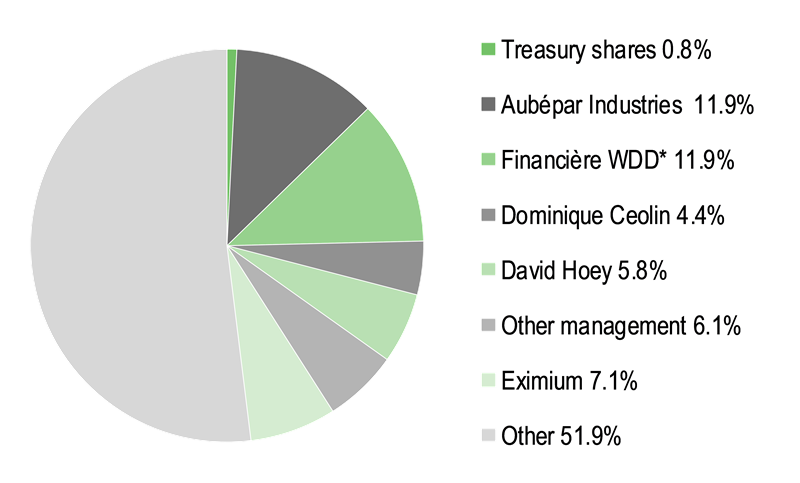External third-party assets under management
In the last decade, ABCA has opened some of its strategies to third-party investors through separately managed accounts and Irish-domiciled Qualifying Investor Funds (QIFs). Funds are created for those strategies that management has rigorously tested and implemented in-house but also have the inherent capacity to absorb more trading capital than the firm can employ on a proprietary basis.
At present, the firm believes it has capacity to offer an attractive home for up to €800m of external capital across its existing strategies, in addition to c €185m of external capital currently employed (of which €124m is in ABCA Reversion Fund; €21m in ABCA Opportunities Fund; and €40m in managed accounts). Priced weekly, the external funds provide useful additional transparency, which demonstrates the return-generating capabilities of ABCA’s models.
This growth in external third-party AUM is supported by a distribution team that aims to build deep and long-term relationships with a relatively limited number of institutional investors, reflecting the niche qualities of ABCA’s fund management proposition and the relatively large minimum investment size of €1m. Management is targeting investors in both Europe and the US, in the belief that more sophisticated investors are better able to understand the relatively technical nature of the investment processes.
The ABCA Reversion Fund had US$187m under management as at end-December 2022 and provides access to liquidity-driven, high-frequency trading models, which aim to exploit short-term price discrepancies in financial markets. The strategy is uncorrelated to broader equity markets, showing -16% correlation to the S&P 500 since inception. ABCA is the investment manager, providing exclusive access to its liquidity models, which are automated but always subject to close human supervision. The firm maintains a 24-hour dashboard on each active model to monitor profitability in real time and enable risk management. There is no concept of a ‘star trader’ or portfolio manager.
The average leverage of the ABCA Reversion Fund is 1.1x, defined as the sum of the fund’s notional longs plus notional shorts, divided by AUM. Leverage typically peaks at a higher level in the middle of the European trading day when all global markets are active.
While systematic, if the trading models are subject to an unusual external factor in the markets such as an earthquake, there is management discretion to not trade and de-escalate. Company experience has shown that unusual events tend to lead to greater profits overall even if there are some early losses. The heightened volatility that follows such an event is typically a target-rich environment for achieving above-average returns.
Returns for the fund since 2010 have historically been strongly correlated to market volatility (see Exhibit 2) and we believe that this relationship should persist in future. Nevertheless, assuming a normalised level of volatility in coming years, we would expect the fund to return somewhat more than its historical average of 6.2%. This is because of significantly higher short-term interest rates compared to the previous decade. Approximately 80% of the fund’s holdings are in cash as a collateral and receive a return based on money market rates.
The most recent performance of ABCA Reversion was somewhat subdued compared to a broader timeline, despite increased volatility amid monetary tightening. The markets experienced unusual spread widening between US and European markets in response to the Russian invasion of Ukraine, which affected the mean-reversion strategy. We believe the markets have adjusted to the ‘new normal’.
Exhibit 2: ABCA Reversion* – an ‘option’ on increased volatility
|

|
Source: ABC arbitrage. Note: *Qualifying Investor Fund.
|
The ABCA Opportunities Fund offers a systematic approach to investing in corporate transactions described by the company as ‘Quant M&A’ and had AUM of US$67m as at end-December 2022. This systemised risk arbitrage strategy has an average holding period per deal of around three months, significantly longer than those of the ABCA Reversion Fund. This strategy has low correlation to equity markets, with a 41% correlation to the S&P 500 since inception.
Risk arbitrage is a strategy that seeks to exploit pricing inefficiencies around the announcement of corporate activity in public markets, such as mergers and takeovers. ABCA employs a disciplined strategy of investing only in announced deals with known terms and an attractive risk profile. The investments are made systematically using a process and database first put in place in 1998.
The strategy aims to exploit the ‘spread’ between the announced terms and the current market price, which is often overly discounted due to an excess of selling pressure as institutional managers rebalance their portfolios following the announcement of public offers. This is a low-beta strategy (we estimate a beta of 0.1 based on the fund’s track record) while generating returns several percentage points above prevailing cash rates. This expected return is similar to that of high-yield bonds but has the advantage of improved liquidity.
The emphasis is on avoiding losses and generating returns through a diversified portfolio of around 50–100 equal weighted holdings, in contrast to traditional risk arbitrage portfolios, which may have as few as 15–25 holdings and a significant skew towards just a few names perceived by the manager as especially attractive.
The diversification policy has historically significantly improved the Sharpe ratio (a measure of the risk-adjusted return) compared to competing funds. Its long-term performance remains highly competitive while volatility is significantly reduced. The overarching portfolio management principle is to quickly identify bad deals but systematically underwrite good ones over the long term, rather than engaging in deal speculation or generating a spectacular return in any single year.
By its nature, this process has more human interaction compared to the systematic trading undertaken within the reversion strategy and there are six analysts working on the portfolio at any one time. Importantly, the strategy does not involve an in-depth fundamental analysis of the entities involved in the M&A deal, but rather a factor analysis developed by ABCA over the years.
A key risk for risk arbitrage-based portfolios is a sudden increase in market volatility. Many of the participants in the market (such as hedge funds or proprietary dealing desks) are leveraged. While in normal markets these participants provide liquidity to institutional fund managers, they can also suffer from their own liquidity constraints in stressed markets. This gives rise to the phenomenon of highly correlated spread-widening, most recently during the initial stages of the COVID-19 pandemic. At such times, there can be significant drawdowns in traditional risk arbitrage portfolios. However, inherent in the design of the ABCA Opportunities Fund is a significant allocation to the ABCA Reversion Fund and a recently introduced equity statistical arbitrage strategy (referred to by the company as a ‘defensive overlay’). Moreover, risk arbitrage returns were affected by the standstill in the M&A markets immediately after the COVID-19 pandemic outbreak (March to July/August 2020).
Exhibit 3: ABCA Opportunities Fund* – strategy contribution
|

|
Source: ABC arbitrage. Note: *Qualifying Investor Fund.
|
The inclusion of returns from the ABCA Reversion Fund acts as an effective hedge against the risk of market dislocation. When volatility increases and risk arbitrage spreads widen, the performance of the liquidity-driven component of the portfolio is expected to improve in a non-linear manner. This hedges the expected spread widening in M&A deals but without incurring the performance hit of maintaining a long volatility option-based hedge. For example, during the COVID-19 pandemic, ABCA Opportunities was down only 4.4% versus a loss of 13.1% for the HFRI Event Driven Index. The year 2022 was characterised by subdued M&A activity amid uncertainty over the extent of economic slowdown, making it difficult to estimate future cash flows and valuations, on top of curbed access to debt financing. As the environment stabilises, we expect an uptick in corporate actions, which should translate to a better performance for ABCA Opportunities Fund.





























